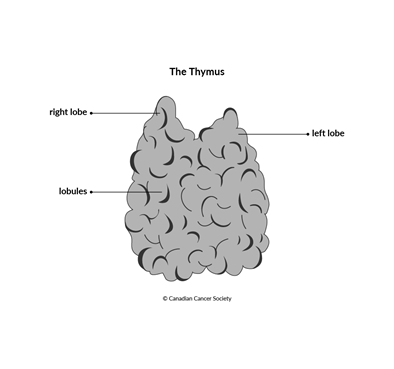The thymus
The thymus is a small, irregular-shaped
Structure of the thymus
The thymus is divided into 2 main parts – a right lobe and a left lobe. Each lobe is divided into smaller sections called lobules that give the thymus its bumpy appearance. Each lobule is made up of a centre part (called the medulla) and an outer layer (called the cortex). A thin covering (capsule) surrounds and protects the thymus.

The thymus is mainly made up of
The thymus changes in size as you get older. It is large in newborns and toddlers. It is biggest during puberty then slowly begins to shrink as adulthood approaches.
The thymus is most active during childhood and youth. By late adulthood, most of the thymus is made up of fat tissue.
What the thymus does
The thymus makes T cells (T lymphocytes) that travel throughout the
body to help fight infection, disease and foreign substances. The thymus also
makes
Lymphocytes travel from the
Your trusted source for accurate cancer information
With support from readers like you, we can continue to provide the highest quality cancer information for over 100 types of cancer.
We’re here to ensure easy access to accurate cancer information for you and the millions of people who visit this website every year. But we can’t do it alone.
Every donation helps fund reliable cancer information, compassionate support services and the most promising research. Please give today because every contribution counts. Thank you.
